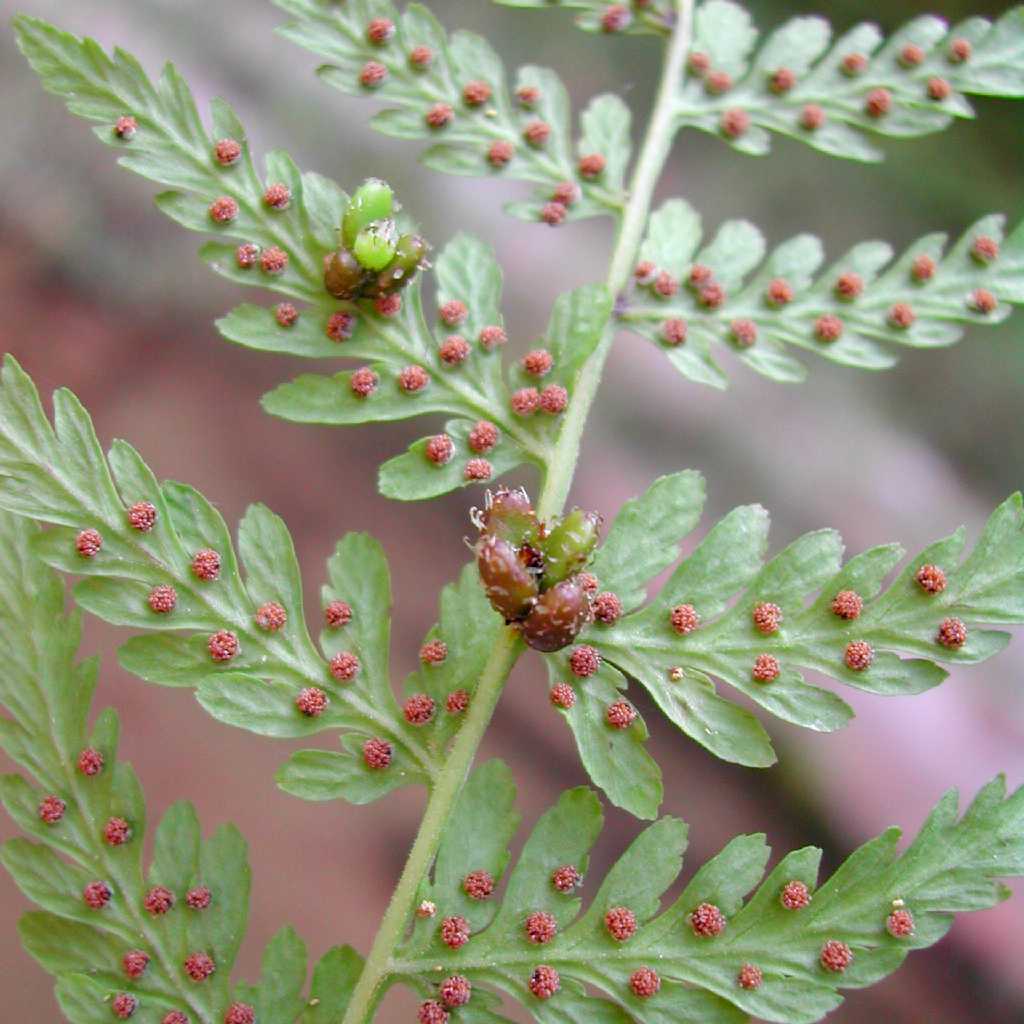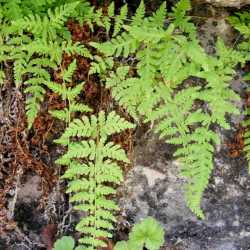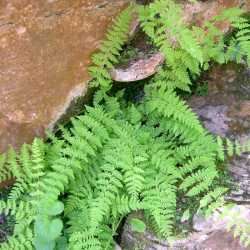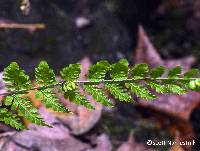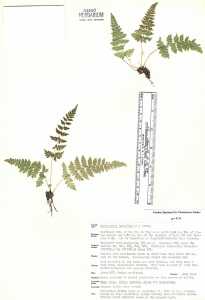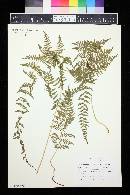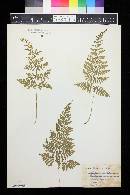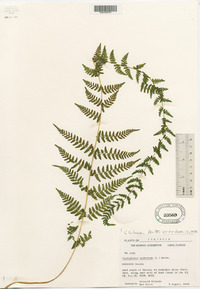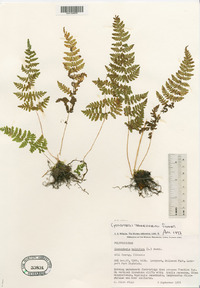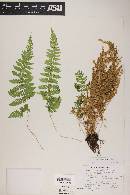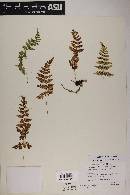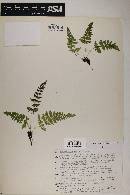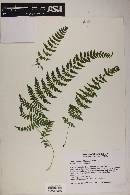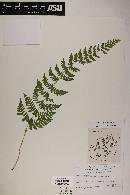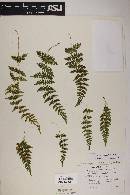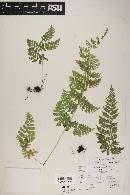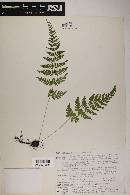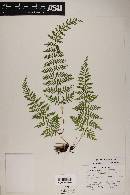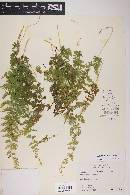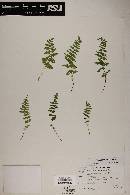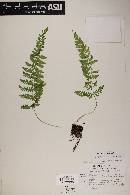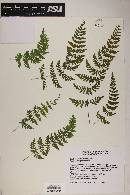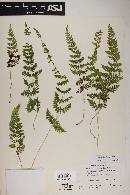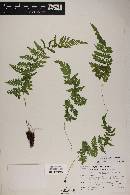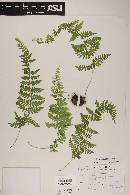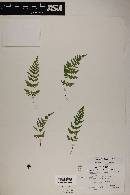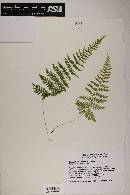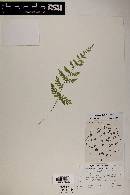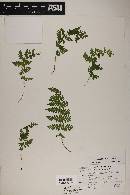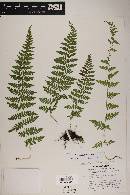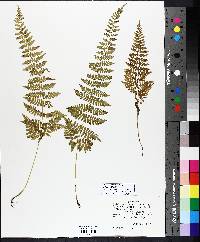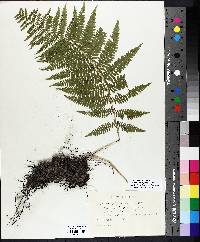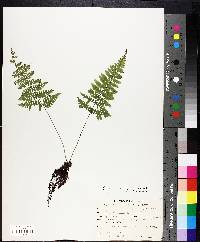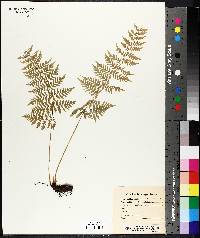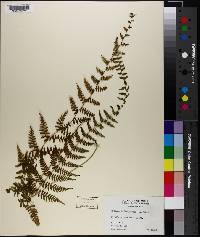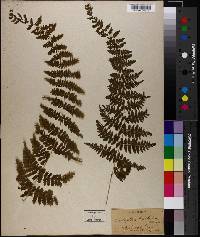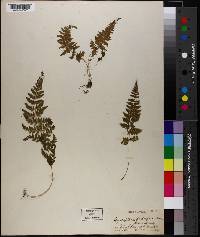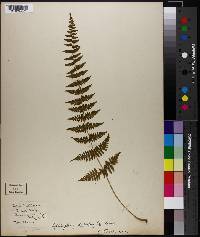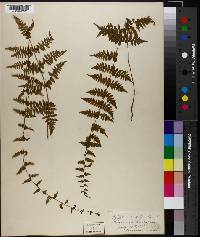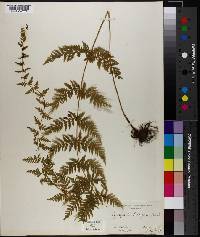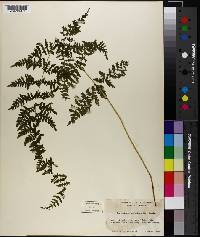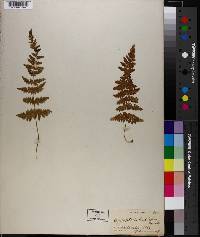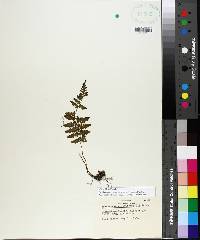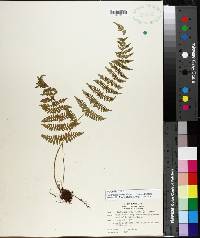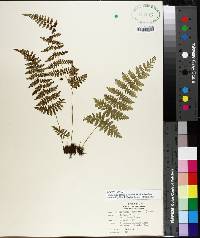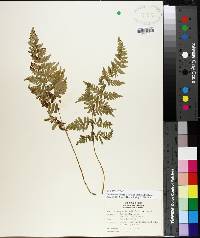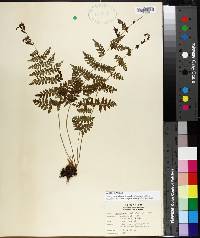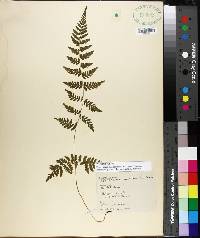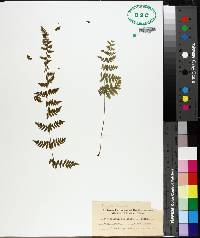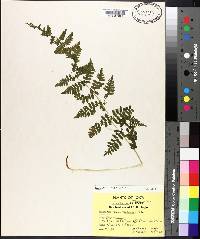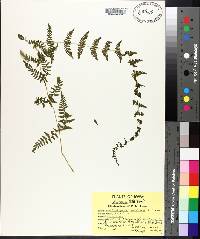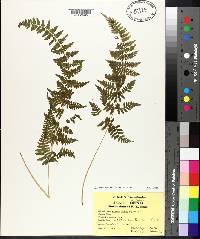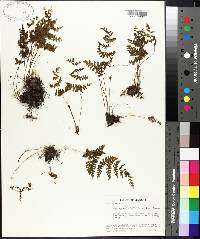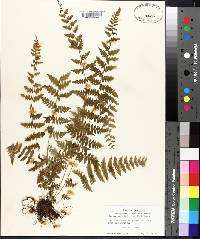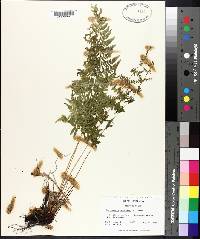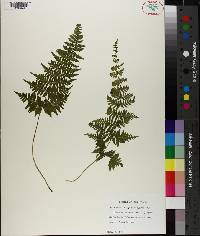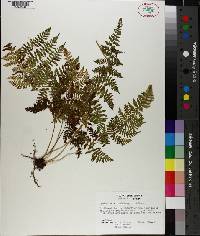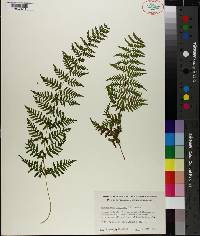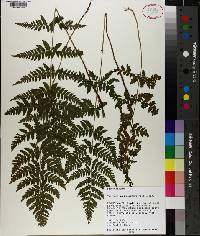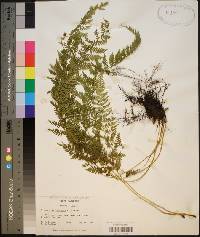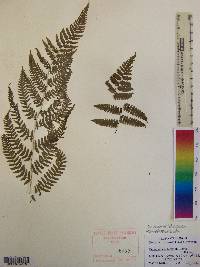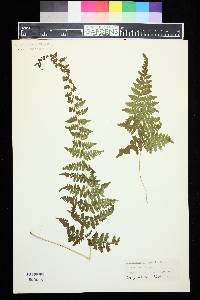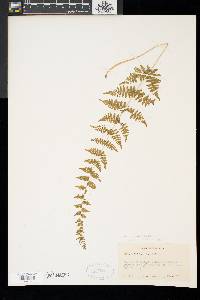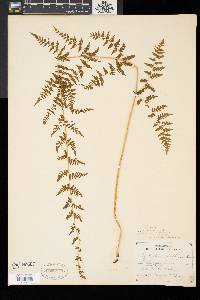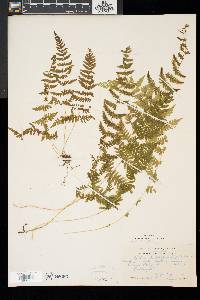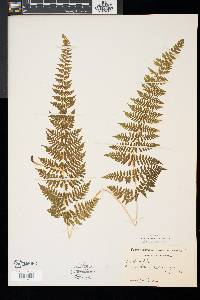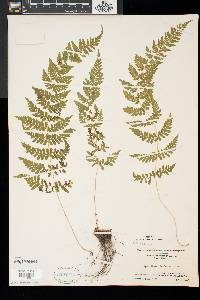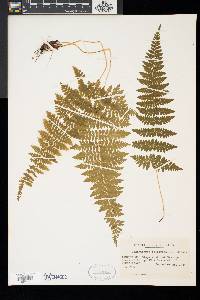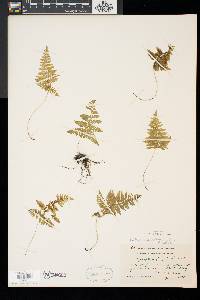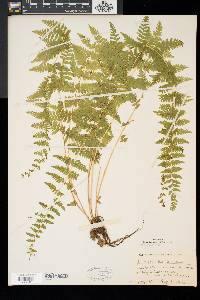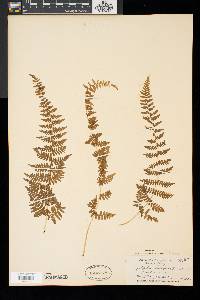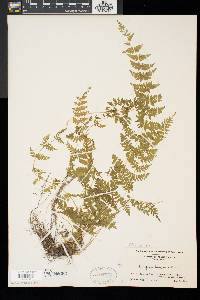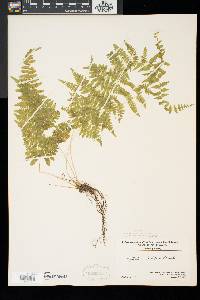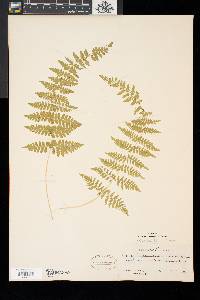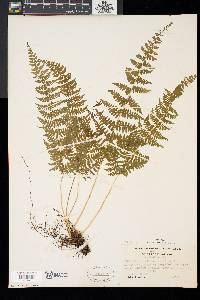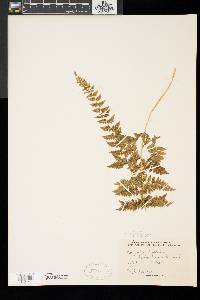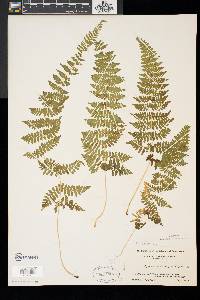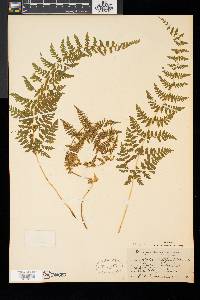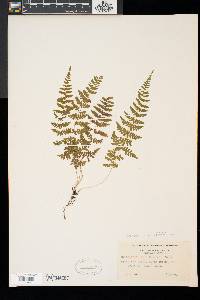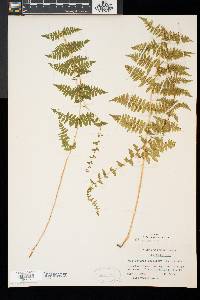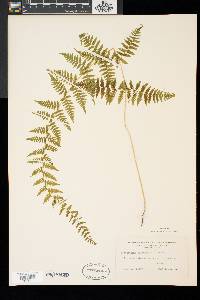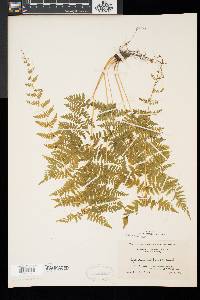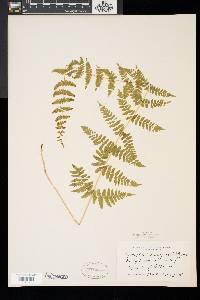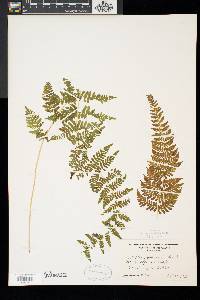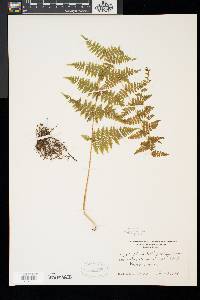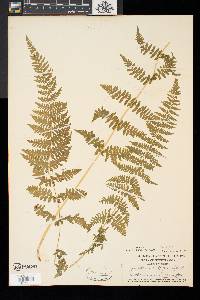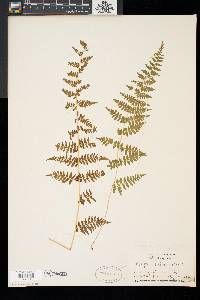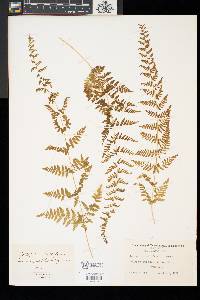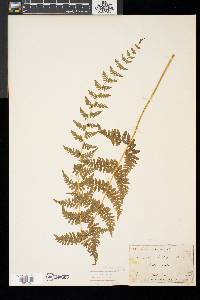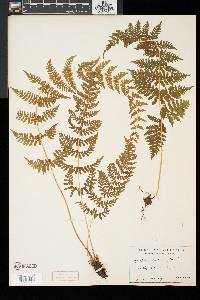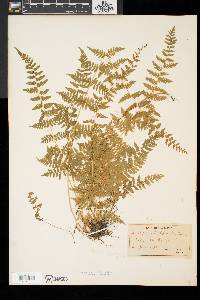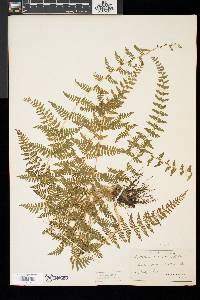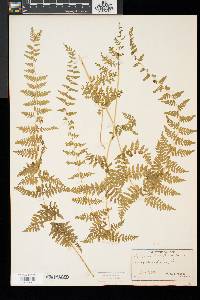Cystopteris bulbifera
|
|
|
|
Family: Cystopteridaceae
Bulblet Bladder Fern, more...bulblet bladderfern, bulb bladderfern
[Aspidium bulbiferum (L.) Sw., moreFilix bulbifera (L.) Underwood] |
Stems creeping, not cordlike, internodes very short, less than 0.5 cm, heavily beset with old petiole bases, hairs absent; scales uniformly brown to somewhat clathrate, lanceolate, radial walls brown, luminae clear. Leaves monomorphic, clustered at stem apex, to 75 cm, seasonally bearing sori (earliest leaves lack sori, subsequent leaves with sori). Petiole reddish when young, usually green or straw-colored throughout (occasionally darker) in mature specimens, shorter than blade, base sparsely scaly. Blade broadly to narrowly deltate, 2-pinnate to 2-pinnate-pinnatifid, almost always widest at base, apex long-attenuate; rachis and costae usually densely covered by unicellular, gland-tipped hairs, often with bulblets; axils of pinnae occasionally with multicellular, gland-tipped hairs. Pinnae mostly perpendicular to rachis, not curving toward blade apex, margins serrate; proximal pinnae pinnate-pinnatifid to pinnatifid, ± equilateral, basiscopic pinnules not enlarged, basal basiscopic pinnules sessile to short-stalked, bases truncate to obtuse; distal pinnae ovate to oblong. Veins directed into notches. Indusia cup-shaped, apex truncate, typically invested with unicellular, gland-tipped hairs. Spores spiny, usually 33--38 µm. 2 n = 84. Sporulating summer--fall. Cracks and ledges on cliffs, rarely terrestrial; usually on calcareous substrates; 0--2500 m; N.B., Nfld., N.S., Ont., Que.; Ala., Ariz., Ark., Conn., Del., Ga., Ill., Ind., Iowa, Ky., Maine, Md., Mass., Mich., Minn., Mo., N.H., N.J., N.Mex., N.Y., N.C., Ohio., Pa., R.I., S.C., Tenn., Tex., Utah, Vt., Va., W.Va., Wis. Cystopteris bulbifera usually occurs on moist calcareous cliffs, but it also grows on rock in dense woods and occasionally occurs terrestrially in northern swamps. Blades on most individuals are narrowly deltate and distinctively long-attenuate. The rachises, costae, and indusia are densely beset with gland-tipped, unicellular hairs. Mature specimens often have deciduous bulblets. These characteristics readily distinguish C . bulbifera from other diploid species. Hybridization and allopolyploidy involving Cystopteris bulbifera and other North American Cystopteris species have generated several species. In the eastern portion of its range, C . bulbifera and C . protrusa are the diploid progenitors of the tetraploid C . tennesseensis (C. H. Haufler et al. 1990). In northeastern North America, C . bulbifera has hybridized with tetraploid C . fragilis , ultimately resulting in the hexaploid C . laurentiana (R. F. Blasdell 1963). In the southwest, the diploid C . reevesiana and disjunct representatives of C . bulbifera are the progenitors of the tetraploid C . utahensis (C. H. Haufler and M. D. Windham 1991). In addition to these fertile allopolyploids, sterile hybrids are also possible when C . bulbifera is sympatric with its polyploid derivatives. Sterile hybrids between C . bulbifera and C . tennesseensis have been identified from several localities. Cystopteris bulbifera may hybridize with C . tenuis to form C . × illinoensis (C. H. Haufler et al. 1990; R. C. Moran 1982b). Diploid sexual C . bulbifera may be distinguished from these allopolyploid species and sterile hybrids because the hybrid-derived taxa (1) will normally have less prominent glandular hairs, (2) will have misshapen bulblets, (3) will more likely have blades that are widest above the base, and (4) will have large spores (in sexual allopolyploids) or malformed spores (in sterile hybrids).
Perennial fern 30 - 80 cm tall Leaves: clustered, stalked, green, delicate, thin, deciduous (dying back in winter), 10 - 60 cm long, 6 - 9 cm wide, widest at base, in outline broadly to narrowly triangular with gradually long-tapered tip, but pinnately compound. The main "midrib" (rachis) usually has at least one well-developed (up to 4 or 5 mm diameter) bulblet beyond its middle. Rhizome: short, compact, but creeping, internodes very short (under 0.5 cm), hairless, but with brown lance-shaped scales, and covered with numerous remnant leaf stalk bases. Leaf stalks: clustered at tip of rhizome, reddish when young then green or straw-colored, shorter than leaf blade, and sparsely scaly. Spores: 64 per sac, brownish, all of one kind, single-sectioned (monolete), usually 33 - 38 microns long, oblong or kidney-shaped, and spiny. Produced seasonally in summer and fall (never on first leaves), the spores give rise to the gametophyte (the sexual phase of the plant), which is small, green, heart-shaped, hairless or often with glands or hairs, and sits above the ground. Similar species: Cystopteris bulbifera is quite similar to C. tennesseensis, but it is uncommon for that species to have bulblets along rachises or costae, it lacks a dense covering of gland-tipped hairs along the final leaf segments and veins, its leaf tips are less gradually tapered, even the earliest leaves bear spore-sac clusters (sori), and typically the spores of that species are larger, over 38 microns. The other three species of Cystopteris in the Chicago Region, C. fragilis, C. protrusa and C. tenuis, differ by not having glandular hairs on any of the leaf portions, the leaf blades are elliptic to lance-shaped and usually widest at the middle or just below the middle, and the rachises and costae never have bulblets. Habitat and ecology: Not common, usually preferring limestone cliffs, which are rare in the Chicago Region, but also found on rocky calcareous slopes, in calcareous woods, and in limy springy places. Occurence in the Chicago region: native Notes: It can be very difficult to separate species within the genus Cystopteris. There is much overlap among leaf morphologies, and consequently one must have a keen eye for subtle and sometimes overlapping characteristics. The species also frequently hybridize with each other, which confuses matters more. Etymology: Cystopteris comes from the Greek words cystis, meaning bladder, and pteris, meaning fern. Bulbifera means bearing bulbs. Author: The Field Museum Common Name: bulblet bladderfern Wetland Status: FAC Etymology: Cystopterisis from the Greek cystis for bladder and pteris fern, referring to the indusium, Larger and coarser than no. 1 [Cystopteris fragilis (L.) Bernh.] , the lvs 3-8(-15) dm, the blade 6-9 cm wide, with (15-)20-30 pairs of pinnae, the lowest pair a little larger than the next pair, the reduced upper pinnae more numerous than in no. 1, so that the lf tapers more gradually to the tip; rachis commonly with 1 or more well developed bulbils on the lower side beyond the middle, these to 4 or 5 mm; costae with scattered pale short-stalked glands; veins mostly ending in the smaller sinuses (reflecting an exaggeration of the tendency seen in some specimens of no. 1 for the principal teeth to be apically indented); indusium brownish, rounded or truncate at the tip, bearing scattered small, pale, short-stalked glands; 2n=84; otherwise much like no. 1 [Cystopteris fragilis (L.) Bernh.]. Gleason, Henry A. & Cronquist, Arthur J. 1991. Manual of vascular plants of northeastern United States and adjacent Canada. lxxv + 910 pp. ©The New York Botanical Garden. All rights reserved. Used by permission. From Flora of Indiana (1940) by Charles C. Deam Infrequent in the southern part of the state, becoming very local to absent in the northern part. This species grows only in wet places or places that are usually constantly kept moist in shady, rocky ravines and in pockets or crevices of shaded cliffs. It is usually found along the outlets of springs in southern Indiana. My Steuben County specimen was found in an old tamarack bog. |

